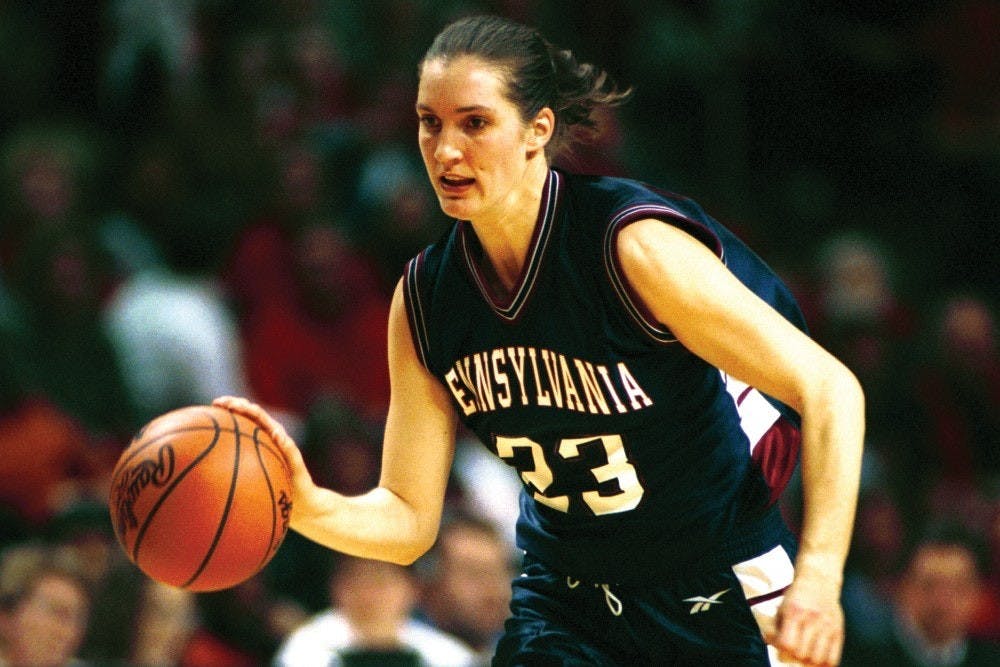Even with the recent string of successful seasons that Penn women’s basketball has managed to put together under the tutelage and leadership of head coach Mike McLaughlin, the best individual team in the program’s history wasn’t one from McLaughlin’s near-decade in charge of the program.
Instead, the most formidable group of Quakers ever to take to the court was the 2000-01 team, which finished 22-6 with an unblemished 14-0 Ivy record that was only the second of its kind. That undefeated mark against the Ancient Eight competition earned the Red and Blue both their first-ever Ivy League title and berth in the NCAA Division I Women’s Basketball Tournament.
The program’s first team to play a full season in the 21st century featured the legendary Diana Caramanico, who to most is the greatest player in Penn history, and who could also lay claim to the title of best player in the history of the Big 5 and Ivy League as a three-time Player of the Year in both leagues.
Caramanico finished her four-year career with the Quakers with an astounding 2,415 points. In the 2000-01 season alone, she averaged a double-double of 21.7 points and 10 rebounds per game. During a matchup with Albany in January of 2001, Caramanico exploded for 42 points, which was a mere point short of the League record.
That spectacular individual season wasn’t, however, the best that Caramanico compiled. The prior year saw the six-foot-two-inch athlete score 24.8 points per game — good for second in the nation among Division I players — on 56.8 percent shooting while grabbing 11.9 boards per game.
Powered by Caramanico’s star and guided by head coach Kelly Greenberg, the 2000-01 team established itself as a trailblazer for the program as a whole. The Red and Blue’s 22 wins were at the time the most in Penn women’s basketball history, and they lay the foundation for McLaughlin’s teams, which have hit the 22-win mark in five of his nine years at the helm.
The 2000-01 group was responsible for many Penn women’s basketball records that still rank highly — if not at the top — of a multitude of statistical categories for the program. Those statistics say a lot about the team’s character:
They were experienced and composed
RELATED:
Penn basketball great Caramanico to be enshrined in Penn Hall of Fame
Freshman Diana Caramanico has become The Center of Attention
The Quakers won 11 games as visitors that year, a number that was then Penn’s best and that is now good for a third-place tie in the school’s record books.
They were clutch
Four wins came in overtime. That mark has since been equalled just once, by the 2011-2012 team.
They made a habit out of winning
Perhaps the most impressive feat of the 2000-01 team was its 21-game win streak. 21 consecutive times, the Red and Blue left the basketball court as the victorious side. No other team in the program’s history has built a streak that even reached double digits. They won 10 straight home games and nine straight road games during that stretch after the starting the season 1-5. They were dominant.
Despite the Quakers’ immense regular season success, they received a 15-seed in the 2001 NCAA Division I Women’s Basketball Tournament, where they squared off against two-seed Texas Tech in the Birmingham, Al. Mideast Regional. Unfortunately for Penn, the Red Raiders snapped the 21-game win streak in a 100-57 victory.
Losing the last game of the season, though, shouldn’t take away from all that the 2000-01 Quakers accomplished. They populated a list of firsts for a program that had long struggled to eclipse mediocrity and whose 18 wins during the previous season were for one year the most in school history. Caramanico’s legend will live forever, as will that of the 21-game winning streak. Penn women’s basketball will always look to this group as a standard-bearer that shines in history and inspires future groups of players to ascend to similar levels of excellence.









